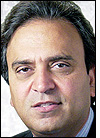Sep 20, 2006North American Bancard (NAB), a provider of payment systems and credit-card processing services, is providing contactless payment systems free of charge to 3,000 retailers, mostly small or midsize, located in the 20 largest U.S. cities.
To carry out its plans, NAB bought ViVOtech ViVOpay 4000 contactless readers and VeriFone Vx570 terminals. Once a merchant deploys the hardware, a customer will be able to pay for purchases with just a tap of an RFID-enabled credit card. The ViVOpay reader will read a tag embedded in the card, then send the tag data to the VeriFone terminal, which will process the transaction through a dial-up or high-speed broadband connection.
The 3,000 readers and terminals represent a pilot for NAB, says the firm's president, Marc Gardner. They will be installed in stores "in the next few months," he explains. At that time, NAB will determine whether to order another set of readers and terminals—and if so, how many.
The initiative is part of NAB's Free Terminal Program, a business strategy in which NAB provides retailers free terminals that are valid for the life of the agreement it has with each merchant. Studies have shown that payments made with contactless cards are faster than those made with cash or credit cards.
"NAB is always looking for new initiatives to help propel our growth," Gardner states. The contactless card system, he says, will benefit retailers that otherwise would not install the systems in their stores due to the expense involved. "There is no incentive for retailers to reach into their pockets to pay for the hardware needed for a contactless card system," Gardner says. "We pick up the expense for them, and in exchange we establish more business."
Banks and credit-card companies have issued more than 17 million contactless credit cards throughout the United States, according to ViVOtech's president and founder, Mohammad Khan. These cards contain an embedded 13.5 MHz RFID chip encoded with payment information, as well as a magnetic stripe on the back to ensure the cards are compatible with traditional payment-card readers prevalent at many retailers.
The ViVOpay 4000 supports all contactless payment platforms, including MasterCard's PayPass, American Express' ExpressPay and those of Discover and Visa.
The entire transaction takes two to four seconds, Khan says, and if the payment is less than $25, no signature is required. The reader measures about 5 inches by 4 inches by .7 inch, and can be mounted on a sales booth or drive-through window, or placed on a checkout counter.
NAB is not the only independent service organization (ISO) showing an interest in contactless readers, according to Khan. In the past three months, ViVOtech has sold more than 10,000 such readers to ISOs, which, like NAB, process online credit-card transactions. ViVOtech has offered its contactless readers for about four years, Khan says, while the first two years were pilots. Since then, sales have been increasing.
The readers offer three benefits for NAB and its retailer customers, Khan explains: allowing NAB to grab the market share of merchants that use credit cards but do not have contactless payment services; improving sales transaction times for existing markets; and bringing contactless card payments to fast-food restaurants, convenience stores, mom-and-pop shops and other merchants that have, until now, been cash-only establishments.
MasterCard recently completed a study of its contactless payment system, PayPass. The study determined that consumers use their payment cards approximately 18 percent more often than non-contactless cards (see RFID Changing Buying Behavior). About 75 percent of the transactions were for purchases less than $25.
ViVOpay readers are also compatible with near-field communications (NFC) technology for RFID-enabled mobile phones, Khan says. Consumers with mobile phones equipped with NFC semiconductor chips will be able to pay using a handset in the same manner as with a credit card.


